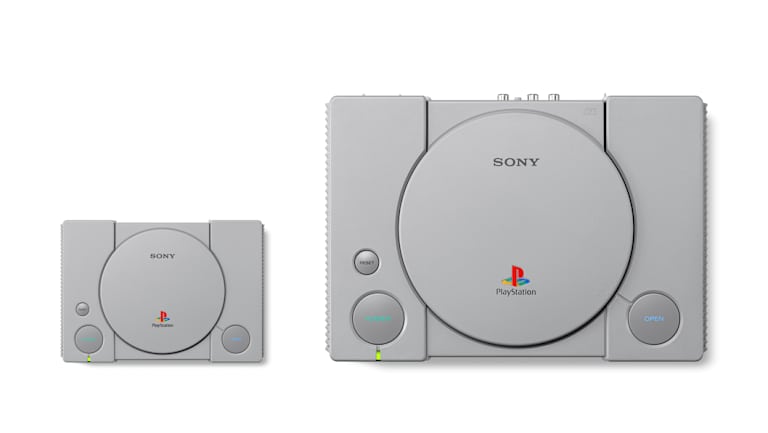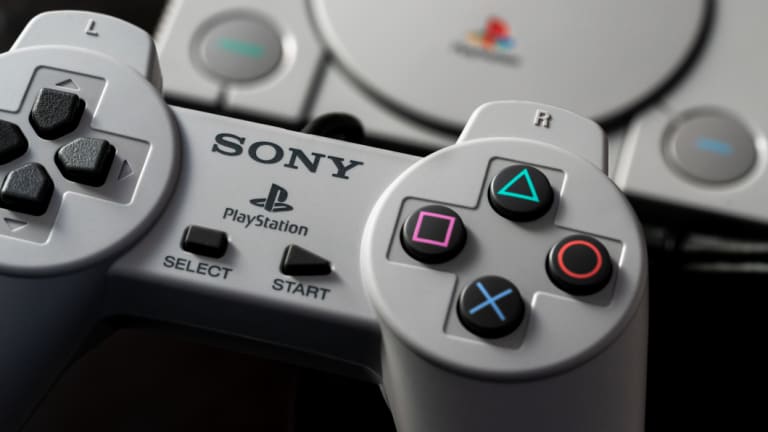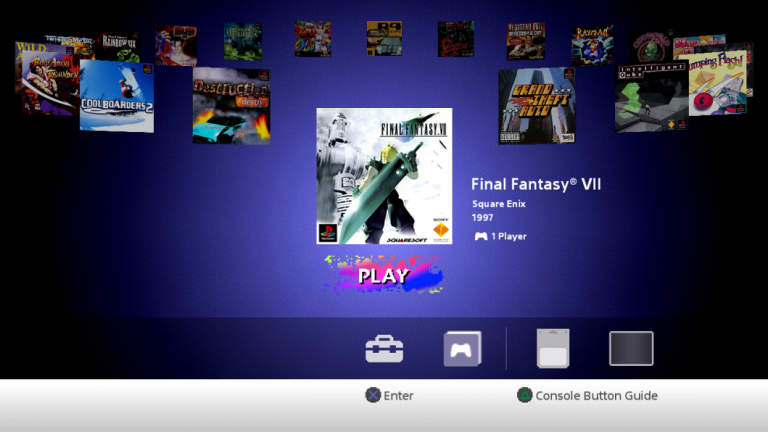
A tiny box of nostalgia
A big part of a classic console's appeal is being able to have a tiny version of your favourite game machine on your shelf, and the PS Classic is handsome indeed. The details are all miniaturised well, from the functioning buttons and tiny grilles down to the flat, non-textured grey plastic (which makes the machine feel a little cheap in hand, given it weighs virtually nothing).

The PlayStation Classic, alongside the 1994 original.
Included is a HDMI cable to connect to your TV and a microUSB cable for power, but no power brick. You'll need to plug it into a spare USB on your TV or use a phone charger. The system outputs a maximum of 720p, making for a bit of an indistinct image on many TVs, and this is made worse by the blurry filter Sony's employed in an attempt to smooth out the jagged edges. But you're not playing games from 1995 for razor sharp graphics.
Also included are two replica PlayStation controllers which feel great and, I believe, have a clickier and more responsive feel than my old PS1 pads ever had. These are in the style of the controllers the PlayStation had at launch, not the ones featuring analog sticks which were introduced in 1997. That's an unfortunate choice given the included games span from 1995 to 1999, and some of them play far better with sticks than with the four directional buttons.
I do appreciate the inclusion of two controllers though, as 10 of the 20 games have multiplayer options. I also love that the controllers are USB (they even work on PC), but are designed to look just like the originals when plugged in. A USB connection also means you should be able to buy extenders so you can actually sit on the couch while you play. At 1.5 metres these cords are too short.

The replica controllers look and feel great.
Twenty of the best?
The game selection itself has some high highs and some middling mediocrity, and while there's some great old-school experiences to be had my overall feeling is that it doesn't do a good job of representing the best of PlayStation.
First of all you have two generation-defining, all-time classics in Metal Gear Solid and Final Fantasy VII. Both games made such good use of the new disc-based medium and 3D graphics rendering as to change what people thought stories and presentation in video games could be, and while they can be a bit awkward and long-winded today both are still excellent.
Then there are lower-tier hits Tekken 3, Wild Arms and Oddworld, plus some off-the-wall picks that were never as popular back in the day but I would argue have aged a lot better if you're looking for a good time in 2018: Mr Driller, Intelligent Qube and Rayman.
There's also Syphon Filter, Grand Theft Auto, Twisted Metal and Resident Evil — good games that had even greater sequels on PlayStation which would have been better picks — and Jumping Flash, which isn't exactly fun but is at least an interesting look at super early 3D platforming.
But then you have the original Rainbow Six and Persona, which are surely only there because the franchises went on to be popular well after the fact, plus two of the console's least interesting high-profile racers in Ridge Racer Type 4 and Destruction Derby (no showing at all from Sony's own Gran Turismo).
It's all rounded out by the meh-inducing Battle Arena Toshinden, Cool Boarders 2 (I guess because Tony Hawk was unavailable) and Super Puzzle Fighter II Turbo.
I'm sure that out there somewhere exist dedicated fans for each of these titles, but for many people it's going to feel like there are seven slots that should have gone to better games.
Loading
The lack of the likes of Crash Bandicoot, Spyro, Tomb Raider and Castlevania here definitely hurts, as those are the kinds of games you immediately think of when it comes to PlayStation, but the reality is Sony is at the mercy of licensing deals when it comes to a lot of its biggest retro properties. What's really weird is that Sony made the choices it did while leaving off some big games it published itself (like Parappa the Rapper or MediEvil), or more titles from publishers that had already contributed games, like Silent Hill from Konami or Dino Crisis from Capcom.
It's possible Sony has intentionally curated a collection as varied in release date, genre and notoriety as possible, and if that's the case it's done a good job. The list does seem representative of the console in the sense that it had a lot of hidden gems, plenty of awkward proto-3D adventures and only the occassional timeless masterpiece, but you might struggle to justify $150 if your favourites aren't here and you're not interested in playing old games purely out of historical interest.
Spinning the discs
When you first boot up the PS Classic you're greeted with the iconic sound and logo, which is as it should be, and then you're taken to an incredibly basic menu for selecting your game. It's certainly of the era — with a static purple background, ragged icons and no music — but it does the job. There are no digital instruction manuals, no ability to rewind or speed up like you might find on other retro collections, just the games. The lack of visual options is the biggest miss, especially if you're after accuracy to the originals, as Sony's blurry filter makes things less pixelly but also less defined, and it can not be turned off.
The system for managing your game saves is simple but clever. Each game is assigned a virtual memory card, so you can save from inside the game in whatever way you did originally. Thankfully, since these games sometimes expected you to go hours between saves, you can hit the "reset" button on the console to pop out of a game to the main menu and create a suspend point, meaning you can pick up where you left off next time. For games that originally had multiple discs, you can hit the console's "eject" button to simulate changing them over when the time is right. Yes, both actions require you to get out of your chair and go over to the console. Takes me back.

The software is spartan, but straightforward.
If I was a bit confused about why Sony chose some of the games it did for this collection, I was outright baffled to find that nine of the games are actually the inferior PAL versions, which run at a lower frame-rate and (usually) a 17 per cent slower speed. PAL games were issued in Australia and Europe to match the 50Hz TVs we had back in the day, but nowadays TVs around the world are all capable of displaying the full-speed NTSC games that went to the US and Japan. In fact the PlayStation Classic outputs at 60Hz, making for jittery performance on the PAL games. There's simply no good reason I can think of for these versions to be used, especially for fast-paced, competitive games like Tekken 3.
Don't get me wrong, all the games here run in a way that you can totally play and enjoy them. Particularly for slower-paced games like Resident Evil and Oddworld, you likely won't even notice that they don't run as their creators intended.
But, just like with the lack of analog sticks, it's disappointing to not get these games at their absolute best.
Should you buy it?
As a lover of the original PlayStation I must admit I was hoping for more out of the Classic. The system looks great but the software packaging is minimal, the best games here have been re-released countless times (by Sony, and in more accurate and more convenient forms), and a good quarter of the games would have a tough time calling themselves "classics".
But while there's a lot that could have been done differently, the PlayStation Classic is still an interesting and worthwhile experience just as it is.
I've very much enjoyed revisiting old favourites, exploring worlds I never gave a proper shot back in the day and finding out about great games I hadn't played at all. I was surprised to find I still remembered exactly how to safely take out bad guys in Syphon Filter despite the archaic controls, and I've developed a drastic addiction to Intelligent Qube, a game I'd never even seen before. Your mileage will definitely vary depending on your familiarity with the included games and your willingness to put up with mid-'90s jank.
I would love to be able to recommend the machine unequivocally to anyone interested in seeing some of the best of this era of games, like I can with the Super Nintendo Classic and the early '90s, but that's not what the PlayStation Classic is. It's a much broader window into the experience of early 3D and disc-based gaming, taking in some of the greatest moments but also some of the less successful, and some of the profoundly weird.
The PlayStation Classic is out on December 3.
Tim is the editor of Fairfax's technology sections.









 Add Category
Add Category